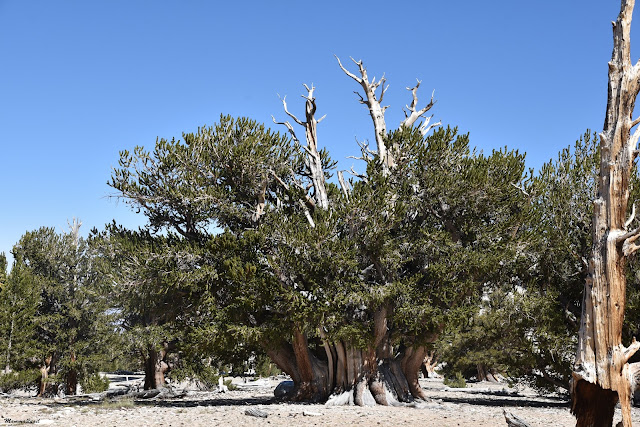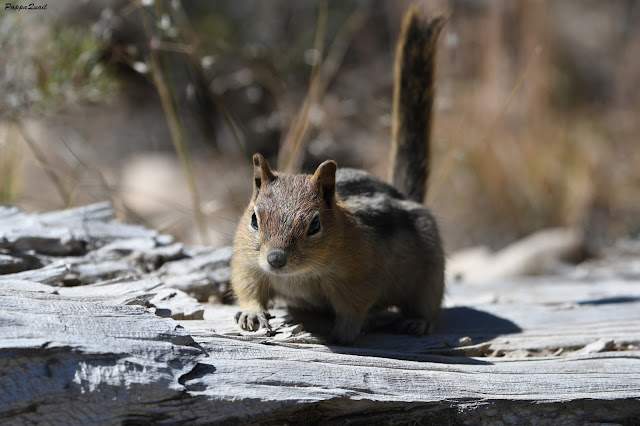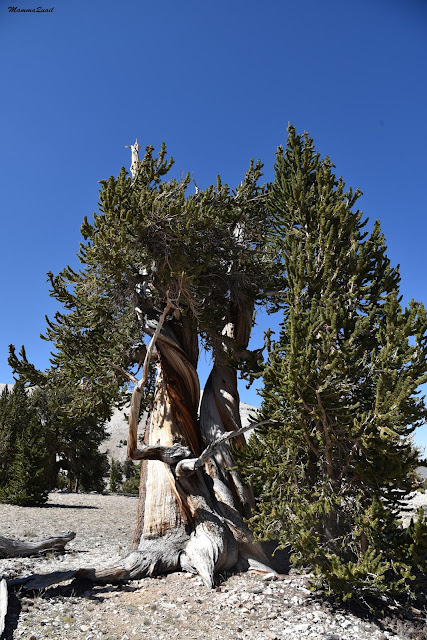There are many places in California that look outlandishly beautiful. The Ancient Bristlecone Pine Forest is no doubt one of these places. I was fortunate to be there several times already. this post is about my latest visit there with my family, Grandma Quail and Papa Quail's nieces last August.

Date: August 12, 2016
Place: Ancient Bristlecone Pine Forest, Big Pine, California
Coordinates of Schulman Grove: 37.385581, -118.178912
Coordinates of Patriarch Grove: 37.527341, -118.198014
Length: Two 1/2 mile loops
Level: easy*
* Altitude: 11,300 ft
The second phase of our family summer road trip was at the Eastern Sierra region. After a long day in which we spent a few annoying hours in traffic jams at South Lake Tahoe, hiked the beautiful Hope Valley Wildlife Area, drove down Monitor Pass, and took a dip in Buckeye Hot Springs, we ended up in the town of Bishop, the big city of Inyo County. We had big plans for the following day: to go up the White Mountains, hike at the Ancient Bristlecone Pine Forest, and hopefully see a Pinyon Jay - a bird that Papa Quail would very much love to add to his list of photographed sightings.
The first wildlife we saw there, however, was a golden-mantled squirrel that was hanging out right by the parking lot of the visitor center at the Schulman Grove.
 |
| Rabbit Brush (Ericameria nauseous), near the Schulman Grove Education Center |
The naturalist told us a great deal about the bristlecone pines and their environment. He told us of dendrology - the science of timing past events and climate changes based on tree growth rings. He also told us of the bristlecone pine sex life, of which we found evidence growing on nearly every tree.
I listened closely to the talk. The chikas soon drifted off, looking at other things, and Papa Quail was soon off too - he saw some birds and followed them.
 |
| Grey Flycatcher, Patriarch Grove |
 |
| Cassie's Vireo, Schulman Grove |
 |
| Uinta Chipmunk, Schulman Grove |
Like all other pines, the Great Basin Bristlecone Pine trees bear male and female cones on the same tree. The male cones are small and clustered at the end of the branch. They produce copious amounts of pollen and release it to be carried by the wind.
The female cones are larger and fewer than the male cones. In their first summer they are open to receive the pollen and then they shut off and go into winter dormancy as the rest of the tree.
After coming out of dormancy in their second summer the female cones grow and the seeds develop inside. The cones are covered with resin to protect them from those who can't wait to have their pine nuts.
 |
| 2nd year female cones ofGreat Basin Bristlecone Pine |
The naturalist pointed at a small pine twig that was poking from the ground between some old cones. Papa Quail pointer his camera there too.
"This," said the naturalist, "is a 10 years old bristlecone pine."
I should probably add (for the benefit of scale) that the cones of this species are nowhere near the size of e sugar pine cone.
It takes many years for a bristlecone pine to become tree-size. They only grow 3-4 months a year. The rest of the time they lay dormant.
The talk took a while and it was nearly lunch time when it was over. At that point it was clear to us that we won't have the time to hike both the Schulman Grove and the higher, Patriarch Grove. So we de decided to pass on hiking the Schulman Grove again and drive right away to the Patriarch Grove.
The Road to the Patriarch Grove is a dirt road covered with loose sharp rocks. The naturalist warned us to drive slowly to avoid getting a flat tire. He told us that they get 2-3 of these each week.
 |
| White Mountain - the road north to the Patriarch Grove |
We heeded the naturalist warning and drove very slowly. It was a beautiful day and the views from that road are spectacular.
There were also quite a few wildflowers in bloom along the road - mostly shrubs. We halted occasionally for Papa Quail to take a quick shot through a rolled-down window.
 |
| Pine Indian Paintbrush (Castilleja applegatei) |
It took us a long time to get from the Schulman Grove to the Patriarch Grove. Not only was the driving slow, but we also had plenty reasons to stop along the way. One of those reasons was a lone feral horse that was grazing by the roadside. The horse didn't seem bothered by our presence. He raised his head and flicked his tail a few times, but other than that he simply kept on grazing. Later we were told by the naturalist that this horse is a fugitive from one of the ranches in Nevada, east of the White Mountains. Each winter the horse would come down to the ranch to be fed and every summer he would take off westward and cross into California to roam the mountains.
I only wish I could do that.
Everyone was famished when we finally arrived at the little Patriarch Grove parking area so we started our visit there with a picnic lunch.
There are two short loop trails at the Patriarch Grove and we had hiked both of them. The first one we hiked was the Cottonwood Overview Trail, leading up to a small peak east of the parking lot.
 |
| Our hike on Cottonwood Overview Trail as captured by Papa Quail's GPS |
We were at the Patriarch Grove only once before, several years ago when the chikas were little. It rained that day and we were already tired after having hiked at the Schulman Grove. I did a quick hike by myself on that hill loop trail while everyone else remained in the car and dosed off.
On our latest visit, however, we had the most beautiful weather we could hope for. Sunny and warm, and no wind. No one remained in the car this time. We packed the picnic leftovers back in the car and headed onto the trail up the hill.
The trees in the grove are nicely spaced, allowing much room for the little plants to grow between them. Some of these plants are truly unique to that area, like the White Mountains Buckwheat with its outstanding crimson inflorescence.
 |
| White Mountain Buckwheat (Eriogonum gracilises) |
 |
| Clokey's Fleabane (Erigeron clokeyi) |
These minute mountain plants are beautiful to see, but the center stage is reserved for the stunning bristlecone pine trees.
Most of the trees there are not actually ancient, most ranging from round saplings to a few centuries old. Here is a (relatively) young bristlecone pine near the trail that didn't seem to be affected much by the elements:
 |
| Great Basin Bristlecone Pine (Pinus longavea) |
 |
| Spike Fescue (Festuca kingii) |
To the northeast grew the rest of the grove - nicely spaced bristlecone pines, dark conifers dotting the pale earth of the mountain.
 |
| Bristlecone Pine Forest |
Papa Quail immediately knew what that light was - a solar tower. With his zoomed photo image and the calculated direction and distance he was able to also identify which one. We were looking at the Crescent Dunes Solar Energy Project - a bombastic 'green' power plant that contributes most to the environment by incinerating unfortunate birds that fly through the mirror-focused sun-heated air around the tower.
 |
| Crescent Dunes Solar Plant |
As we came down the hill the trail took us near some really twisted looking trees. Environmental conditions on the white mountains are harsh and many of the older trees are partially dead. Unlike animals, trees continue to live as long as they have intact strip of bark from roots to foliage. While parts of the tree succumb to the harsh conditions and die, the living part of the tree continues to grow and thrive, shielded to some extent by the dead wood mass it's still attached to.
And these partially dead trees are very beautiful and impressive to look at.
As we made our way back to the parking lot I looked back at the hill. Such a beautiful and unique place it is. I hope to go back there again soon.
We had a quick break and then I pushed on to the second loop - the Timberline Ancients Nature Trail. On this loop, I was told, was the Patriarch Tree - the oldest tree in that grove and the one after which the entire grove was named.
This track doesn't involve any climbing and now wide views distract from the magnificence of the nearby trees.
For a trail among the ancient trees it featured many much younger pines, all growing vigorously.
A few bird calls - and Papa Quail was off to follow the caller.
 |
| Black-throated Grey Warbler, Patriarch Grove |
And as old as they may be, they are still reproductive, producing cones.
 |
| 1st ab 2nd year female cones |
 |
| Ancient Bristlecone Pine (Pinus longavea) |
 |
| Limber Pine (Pinus flexilis) |
Almost every step along the hike (and the previous one too) I saw this little yellow composite: it was in peak bloom at the time of our visit.
 |
| Alpine flames (Pyrrocoma apargioides) |
(And Papa Quail's niece wondered why did we have to hike the entire loop just to see the this tree when it is right by the car ... )
 |
| The Patriarch (Pinus longavea) |
What I do not understand is why this wonder tree was named The Patriarch. After all, it was bearing female cones. Yes, at 4000 plus it is still reproductive. How's that for impressive!
The rest of the family caught up with me and we all circled The Patriarch and admired it thoroughly, until one by one our little group dispelled and moved back toward the car.
Just as we were pulling out of the parking area Papa Quail noticed a mountain bluebird standing on a nearby dead tree.
The first time we've seen mountain bluebirds was on the White Mountains. We've seen them on several occasions since but here was an opportunity to finally get a good photo of this pretty bird.
 |
| Mountain Bluebird, male |
 |
| Mountain Bluebird, female |
One of the bonuses of mountain birding is that you also get to see the bird from above :-)
 |
| Red-tailed Hawk, Juvenile |
 |
| A view of the Sierra Nevada from the White Mountains |
 |
| Desertsweet (Chameabatiaria millefolium) |
 |
| Silvery Lupine (Lupinus argenteus) |
On the way down to the Schulman Grove I drove much faster, trusting that the car won't get a flat. And it didn't - not on that drive.
 |
| Approaching the Schulman Grove of Great Basin Bristlecone Pines. |
 |
| Soda Straw (Angelica lineariloba) |
The campground is at a considerably lower elevation than the bristlecone pine area. There are no bristlecone pines there, but the common Pinyon Pine-Utah Juniper community that is characteristic of the Great Basin mountain ranges.
On our first visit to the White Mountains we had camped there. Our elder chika was then the only chika and she was 18 months old. Papa Quail and I were busy pitching our tent, and when we finished and I turned to look at my daughter I found her standing by the nearest juniper and stuffing her mouth with its cones.
Needless to say I got panicked . But she didn't choke, and later I found out that juniper 'berries' aren't toxic. Still, it was a frightening experience.
 |
| Utah Juniper (Juniperus osteosperma) |
And it was there that we discovered that the jack that arrived with the car when it was brand new didn't really fit it. We had to get a rock underneath the jack to get the needed lift and even with that we had to dig some under the tire.
The whole ordeal took us over an hour, during which the chikas and even their cousins got into fights and ceaseless nagging. Needless to say by the time we were out of there on out spare tire we were all exhausted and not interested at all in chasing the pinyon jay any more.
 |
| Pinyon Pine (Pinus monophylla) |
Many thanks to members of the Birding California group for their help in identifying the birds, and to members of the California Native Plants Society for their help in identifying plants!

















Many interesting and beautiful sights... The old trees are very impressive.
ReplyDeleteIt's a very unique place. A must see next time you make it across the pond :-)
Delete